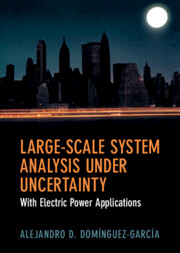Book contents
- Frontmatter
- Dedication
- Contents
- Preface and Acknowledgments
- Notation
- 1 Introduction
- 2 Preliminaries
- 3 Static Systems: Probabilistic Input Uncertainty
- 4 Static Systems: Probabilistic Structural Uncertainty
- 5 Discrete-Time Systems: Probabilistic Input Uncertainty
- 6 Continuous-Time Systems: Probabilistic Input Uncertainty
- 7 Static Systems: Set-Theoretic Input Uncertainty
- 8 Discrete-Time Systems: Set-Theoretic Input Uncertainty
- 9 Continuous-Time Systems: Set-Theoretic Input Uncertainty
- Appendix A Mathematical Background
- Appendix B Power Flow Modeling
- References
- Index
9 - Continuous-Time Systems: Set-Theoretic Input Uncertainty
Published online by Cambridge University Press: 17 January 2022
- Frontmatter
- Dedication
- Contents
- Preface and Acknowledgments
- Notation
- 1 Introduction
- 2 Preliminaries
- 3 Static Systems: Probabilistic Input Uncertainty
- 4 Static Systems: Probabilistic Structural Uncertainty
- 5 Discrete-Time Systems: Probabilistic Input Uncertainty
- 6 Continuous-Time Systems: Probabilistic Input Uncertainty
- 7 Static Systems: Set-Theoretic Input Uncertainty
- 8 Discrete-Time Systems: Set-Theoretic Input Uncertainty
- 9 Continuous-Time Systems: Set-Theoretic Input Uncertainty
- Appendix A Mathematical Background
- Appendix B Power Flow Modeling
- References
- Index
Summary
This chapter covers the analysis of linear and nonlinear continuous-time dynamical systems described by a continuous-time state-space model whose input belongs to an ellipsoid. Similar to the linear discrete-time case, the set containing all possible values that the state can take is not an ellipsoid in general, but it can be upper bounded by a family of ellipsoids whose evolution is governed by a differential equation that can be derived from the system state-space model. As in the discrete-time case, it is possible to choose ellipsoids within this family that are optimal in some sense. The nonlinear case is again handled using linearization. The techniques developed in the chapter are used to analyze the performance of a buck DC-DC power converter. In addition, we show how the techniques can be used to assess the effect of variability associated with renewable-based electricity generation on bulk power system dynamics, with a focus on time-scales involving electromechanical phenomena.
Keywords
- Type
- Chapter
- Information
- Large-Scale System Analysis Under UncertaintyWith Electric Power Applications, pp. 273 - 306Publisher: Cambridge University PressPrint publication year: 2022

